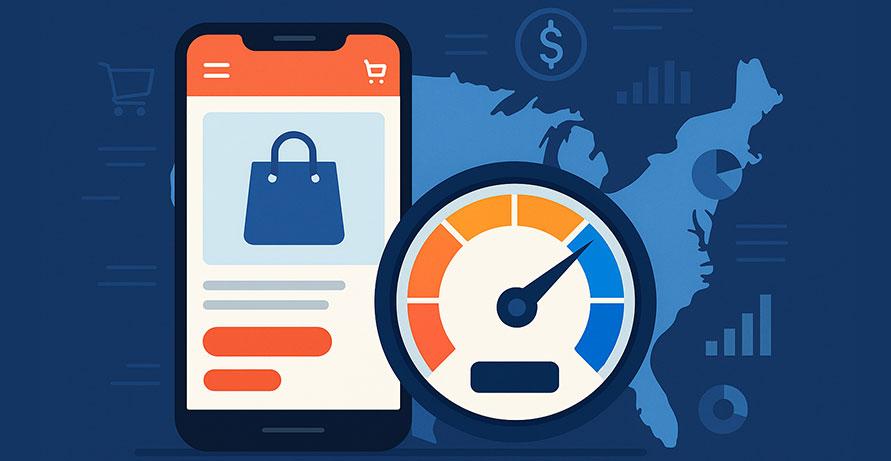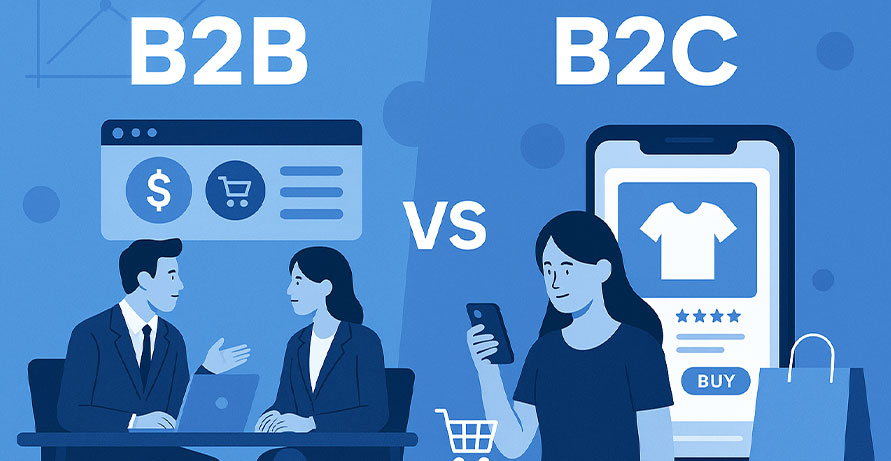Mobile Commerce in the U.S.: Why Speed Equals Sales

Mobile commerce has transformed how Americans shop. In 2025, more than 65 percent of all U.S. e-commerce transactions are expected to occur through mobile devices. Yet many brands still lose revenue for one simple reason: slow mobile performance.
This article explains why mobile speed directly affects sales, customer satisfaction, and search visibility. It also outlines current trends, speed benchmarks, and optimization strategies that help U.S. businesses improve conversions and profitability.
At Anchor Points, we build high-performance mobile commerce systems designed to load quickly, rank higher, and convert visitors into loyal customers.
The Rise of Mobile Commerce in the U.S.
Mobile commerce, or m-commerce, refers to buying and selling through smartphones or tablets. What started as a convenience has now become the dominant online shopping channel.
Recent research shows:
- Mobile contributes roughly 65 to 70 percent of total e-commerce sales.
- The average American spends more than four hours daily on their phone.
- 79 percent of users say they are more likely to return to mobile-friendly stores.
- Even a one-second delay can reduce conversions by nearly 20 percent.
Consumers expect fast, intuitive experiences from every site they visit. Businesses that fail to deliver lose shoppers before they even reach checkout.
How Anchor Points Helps:
We specialize in building mobile-first e-commerce platforms that combine speed, simplicity, and security. Our technical teams apply lightweight architecture, responsive design, and caching layers to ensure your store performs flawlessly on every device.
Why Mobile Speed Matters
Mobile performance affects far more than just loading time. It shapes brand perception, search rankings, and ultimately, sales.
Speed and Conversions
When a website loads quickly, customers stay longer and are more likely to purchase. According to Deloitte, improving site speed by just one-tenth of a second can boost conversion rates by eight percent.
Speed and SEO
Google’s ranking algorithms prioritize websites that load fast on mobile devices. A slow site not only frustrates users but also ranks lower in search results, cutting off valuable traffic.
Speed and Customer Trust
A fast site communicates credibility. When users can browse and buy without delays, they are more likely to trust the brand and return for future purchases.
How Anchor Points Helps:
We conduct complete mobile audits, resolve performance bottlenecks, and integrate global content delivery networks (CDNs). Our optimization process improves both user satisfaction and SEO visibility.
Mobile User Behavior in 2025
Modern shoppers expect frictionless experiences on mobile. They no longer distinguish between desktop and phone browsing, yet their on-the-go behavior requires more streamlined design.
What Defines Mobile Shopping Today:
- Short browsing sessions that demand quick navigation.
- One-handed interactions with thumb-friendly layouts.
- Instant decision-making based on visuals and speed.
- An expectation of effortless checkout.
Any delay or cluttered design creates frustration and lost sales.
How Anchor Points Helps:
We analyze user interactions using analytics and heatmaps, then refine layouts for intuitive mobile journeys. By minimizing scripts and optimizing visual loads, we deliver experiences that keep users engaged from the first click to checkout.
The Real Cost of a Slow Site
Even minor performance issues can have a significant financial impact. Studies show that:
- A two-second delay can cause nearly 90 percent of mobile visitors to leave.
- More than half of shoppers abandon pages that take longer than three seconds to load.
- Amazon once estimated that every one-second slowdown could cost $1.6 billion annually.
- Faster sites often achieve double the average order value of slower ones.
A slow site wastes marketing spend because visitors drop off before conversions occur. Optimizing for speed is one of the most cost-effective ways to increase revenue.
How Anchor Points Helps:
We use image compression, efficient caching, and server optimization to improve load times. By focusing on measurable metrics such as time to first byte and total blocking time, we help clients achieve faster performance across devices.
Optimizing Mobile Checkout
A fast site alone is not enough if checkout is complicated. Mobile buyers expect quick and simple payment experiences.
Best Practices for Checkout Optimization:
- Enable guest checkout and digital wallets such as Apple Pay and PayPal.
- Minimize the number of required form fields.
- Offer autofill options for address and payment data.
- Include clear trust indicators and SSL security badges.
- Keep confirmation pages lightweight and fast.
How Anchor Points Helps:
We streamline checkout flows with secure payment integrations and intuitive UX. Our approach reduces cart abandonment and ensures customers complete their purchases without hesitation.
What Defines a Fast Mobile Experience
A fast site is one that feels instantaneous. To achieve this, businesses must focus on reducing loading delays, improving interactivity, and preventing layout shifts.
A high-performing mobile site should:
- Display the first visible content in less than two seconds.
- Load the main product or headline image in under three seconds.
- Maintain a stable layout while loading to avoid visual disruptions.
- Allow smooth scrolling and fast response to user input.
Meeting these goals not only improves customer satisfaction but also strengthens SEO performance.
How Anchor Points Helps:
We use Google Lighthouse and real-user testing to evaluate performance. Our team then applies code optimization, caching, and asynchronous loading techniques to achieve a consistently fast user experience.
Progressive Web Apps: The Next Step
Progressive Web Apps, or PWAs, combine the benefits of a website and a mobile app. They load instantly, work offline, and provide app-like interactivity directly through the browser.
Why PWAs Are Gaining Popularity:
- Faster load times even with weak connections.
- Reduced dependency on app stores.
- Improved engagement through push notifications.
- Conversion rates that are 30 to 40 percent higher than traditional mobile sites.
How Anchor Points Helps:
We develop PWA-based e-commerce platforms that deliver app-quality performance in a browser environment. Our PWAs boost engagement, speed, and retention without requiring customers to download an app.
Real-World Example
A leading apparel retailer in the U.S. partnered with Anchor Points to enhance their mobile store. After implementing performance optimizations, the results were striking:
- Load times dropped from nearly five seconds to under two seconds.
- Bounce rate fell by 41 percent.
- Conversion rate increased by 28 percent.
- Organic traffic improved by 18 percent in two months.
This success demonstrated how mobile speed directly translates into measurable revenue growth.
Future Mobile Commerce Trends
Mobile technology continues to evolve rapidly. The next wave of innovations will focus on intelligence, personalization, and speed.
Key Trends for 2025:
- Voice-enabled shopping through assistants like Alexa and Siri.
- Visual search that lets users find products using photos.
- AI-driven product recommendations based on behavior.
- Augmented reality previews that simulate real-world use.
- 5G and edge computing that reduce latency and improve responsiveness.
How Anchor Points Helps:
We integrate these emerging technologies into modern mobile ecosystems. Our team ensures each feature enhances performance instead of slowing it down, creating faster and smarter user experiences.
Final Takeaways
Speed is the foundation of success in mobile commerce. The faster your website loads, the more sales you generate, the longer customers stay, and the higher your search rankings climb.
A one-second improvement in load time can make a dramatic difference in revenue. Businesses that focus on performance optimization build stronger brands, retain more customers, and maximize every advertising dollar.
How Anchor Points Supports You:
Anchor Points creates mobile commerce systems that are fast, secure, and future-ready. Whether upgrading your existing platform or building a new mobile-first store, we ensure your site delivers the kind of speed and efficiency modern consumers expect.
Want to know how your mobile site performs? Contact Anchor Points for a free performance audit and discover how faster load times can transform your sales and brand reputation.
FAQs
Q1. What is mobile commerce?
Mobile commerce refers to purchasing products or services using smartphones or tablets.
Q2. How does speed affect online sales?
A faster website keeps users engaged longer, leading to higher conversions and repeat visits.
Q3. How can I measure my site’s mobile speed?
You can use Google PageSpeed Insights, GTmetrix, or Lighthouse to evaluate and improve performance.
Q4. What are Progressive Web Apps, and should I consider one?
PWAs are web applications that work like mobile apps, offering faster load times and offline capability. They are ideal for growing mobile-first e-commerce businesses.
Q5. How does Anchor Points help with mobile optimization?
Anchor Points provides full-stack optimization, including code refinement, caching, responsive design, and performance testing to ensure faster, smoother experiences.








